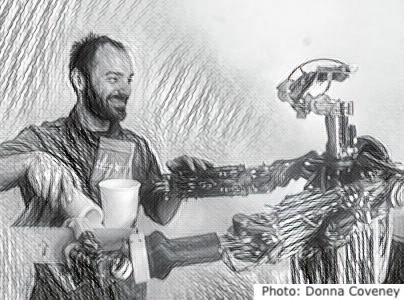Aaron Edsinger
Robotics researcher, entrepreneur, and inventor Aaron Edsinger dreams of a day when intelligent robots may provide safe and reliable assistance to humans for a variety of everyday tasks. He has developed a humanoid, robotic torso, dubbed Domo, which brings that dream closer to a reality.
Built for research purposes, Domo has human-like qualities such as a compliant arm, motion recognition, and force-sensing abilities that make it adaptable to new environments and conditions. Adaptability, according to Edsinger, is critical for taking robots into the realm of everyday human life. He hopes his research will eventually lead to robots that can assist people with tasks such as housework, manufacturing, healthcare, and assistance for the elderly and the handicapped. Robots based on his designs could also help with agricultural work and tasks performed in space.
A California native born in 1972, Edsinger grew up working on a farm, where as a youngster, he began dreaming up designs for labor-saving devices such as a robot arm to load bales of hay onto a truck. When he was 12, he made a tele-operated robot hand out of wood and wire to change the dial on the TV. He entered Stanford University in 1990, where he completed a BS in Computer Science in 1994.
A self-taught artist, Edsinger built robotic sculptures in San Francisco in the late 1990s before deciding to pursue graduate studies. He was inspired by his art to learn more about robots so that he could program his creations to do the things he wanted them to do. He completed SM and PhD degrees at the Massachusetts Institute of Technology (MIT) in 2000 and 2007, respectively, both in computer science.
Edsinger developed Domo while working as a research assistant in the university’s Living Breathing Robots Group, under the direction of Professor Rodney Brooks. Domo is designed to be deployed safely around people and encourages natural interactions with its human form and style of motion. The 29-degree-of-freedom, force-controlled device uses an arm that is compliant; in other words, when one pushes on it, the arm complies to the pushing force, making it less likely to harm a person interacting with it. The machine also uses a novel type of actuator called a Series Elastic Actuator, a linear elastic element placed between the motor and the joint. The inherently low output impedance of an SEA makes it suitable for applications where human safety is important.
The device uses electronic “eyes” to “see” what’s happening in front of it and is programmed to determine the size of an object it picks up and holds by focusing on its tip. Named for the lyric within the popular 1980s rock song by Styx – "Domo Arigato, Mister Roboto" – its eyes are designed to be able to maintain eye contact with humans, which makes interaction and communication more “true to life,” so to speak. Edsinger’s presentation on Domo won the prestigious Best Paper Award at Humanoids 2006.
Meanwhile, Edsinger also signed on that year as a Design Consultant with Gehry Partners in Santa Monica, California, working for renowned architect Frank Gehry. He was part of a team there charged with developing a $3.4 billion project proposal in Singapore for the “Gardens of Robotica,” a fantastical, interactive botanical garden where the flora and fauna are both real and robotic.
He has co-founded two robotics companies, Meka Robotics and Redwood Robotics, to develop and commercialize core technologies he developed. In 2013, Google X acquired Meka Robotics and Redwood Robotics.
Edsinger currently works as director of the Google Robotics initiative.


